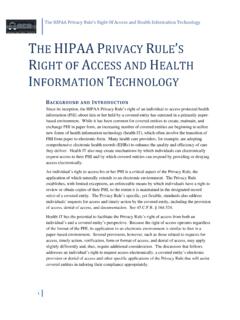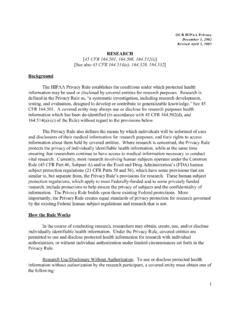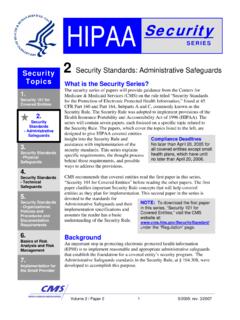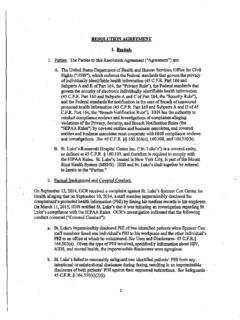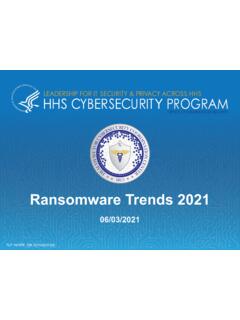Transcription of Physical Access Control - HHS.gov
1 Physical Access Control11/14/2019 Report #: 201911141000 AgendaTLP: WHITE, ID# 2019111410002 overview Physical Access Control Common Applications Physical Threats to Data Attack Scenario Physical Access Control Systems (PACS) Healthcare Impacts GhostExodus Internet-of -Things (IoT) Devices Crime Prevention Through Environmental Design (CPTED) Environmental Threats Security Assessment Supplemental GuidanceNon-Technical: managerial, strategic and high-level (general audience)Technical: Tactical / IOCs; requiring in-depth knowledge (sysadmins, IRT)Slides Key:3 overview The protection of Physical computer systems, organizational assets, infrastructure, and personnel are all under the scope of Physical security Physical security represents a part of an overall cybersecurity approach that is just as important as technical elements. Physical Access Control incorporates numerous capabilities to prevent, detect, or correct unwanted intrusions into an organization.
2 Using simple techniques such as theft or accessing an on-site workstation, cybercriminals can potentially steal private data residing on enterprise systems. Physical Access Control systems which are commonly used to secure businesses, have commonly seen risks associated with the integrated technology. In healthcare, the rise of IoT systems vulnerable to proximity-based attacks highlights the need for Physical security standards. A number of examples of Physical security impacts to healthcare systems exist, including multiple instances of computer theft per year, and highly sophisticated attacks done in close proximity to medical devices. Similar to auditing computer systems and networks in an organization, a Physical assessment of an organization s Physical security can identify risk areas in which to incorporate best practices. TLP: WHITE, ID# 2019111410004 Physical Access Control Physical Access Control ( Physical Security Control ) focuses on the Physical protection of information, buildings, personnel, installations, and other resources.
3 Restricts Physical Access by unauthorized personnel The Physical attack vector regarding cybersecurity is often overlooked compared to more technical vectors. Used to mitigate a variety of threat types: Source: Infosec Institute Sabotage, vandalism, theft Eavesdropping (key loggers, cameras, shoulder surfing) Natural disasters tornadoes, earthquakes, floods, tsunamis Man-made disasters terrorism, arson, bombings Loss of Access to electricity, air, and water. Security Controls, Source: F5 Physical Access Control represents one of the three fundamental security controls that make up computer : WHITE, ID# 2019111410005 Common Applications A number of capabilities exist to strengthen Physical security Security controls and the capabilities within them are often divided into separate functional categories Preventative stops unauthorized activity from occurring Detective detects and alerts to unwanted or unauthorized activity in progress Corrective repairs damage or restores resources and capabilities to their prior state following an unauthorized or unwanted activity.
4 Image Source: Trend MicroPreventativeBadgesMantrapsFencesLoc ksGuardsTrainingDetectionMotion SensorsIntrusion AlarmsCameras/CCTVL ightsCorrectivePhysical RepairsAdministrative UnlocksRe-issuing Access cardsCommon Physical Security ApplicationsTLP: WHITE, ID# 2019111410006 Physical Threats to Data Cyber threats to an organizations computer systems are often mistakenly thought of as being solely technical There are a number of Physical threats, malicious and unintentional, that can negatively impact an enterprise system. A number of cyberattack campaigns have incorporated a Physical element into an overall operation. Stolen Devices Unsecure devices that are stolen can potentially contain sensitive data that can be extracted by the cybercriminals Proximity scanningImproperly Encrypted IoT Devices such as nurse stations and imaging devices can be accessed with small computing devices, if close enough, and potentially used to attack other devices on the same network.
5 Manual Malware uploadPhysically accessible systems can be easily infected with malware via USB or optical disk. Physical Destruction Malicious outsiders, disgruntled employees, or environmental factors can damage accessible equipment, risking data loss and disrupting operations. Physical malicious threat examplesTLP: WHITE, ID# 201911141000 Physical Access Control Systems - PACS7 Physical Access Control Systems (PACs) are used as an electronic security counter measure that can Control Access to a facility within controlled interior areas. Commonly made up of many software and hardware components such as software applications, servers, databases, panels, door controllers, and workstations. Typically interoperates with an Intrusion Detection system, Video management system, and a visitor management system. Often issues PIV ID Cards supported by a certificate validation system and hardware infrastructure.
6 Although PACs are recommended as a Physical security practice, they are not without flaws. PAC software is susceptible to hardware/software vulnerabilities. Source: Security Boulevard, GlobenewswireReal-world PAC Vulnerability Example On January 2019, multiple Zero-day vulnerabilities were discovered in a PACs technology suite developed by IDenticard When exploited, the vulnerabilities would give attackers unrestricted Access to the badge system database, allowing them to enter buildings by creating fraudulent badges and disabling building locks. According to the IDenticard website, IDenticard has tens of thousands of customers around the world, including Fortune 500 companies , K-12 schools, universities, medical centers and government agencies. Common issues with PACs systems Vendor solutions implemented without testing PACs using outdated software/hardware No maintenance or support after installation Lack of strong encryption on devices Heavily reliant on IT but may lack understandingTLP: WHITE, ID# 201911141000 Healthcare8 Physical Security is particularly important in the healthcare industry due to: PHI data that resides in hardware devices must be secured.
7 The accessible nature of hospitals and healthcare facilities further drives the need for Physical security protections. Many modern medical devices incorporate Internet of things/network technology that can be exploited to steal data or Access networks. The pervasive use of mobile devices in healthcare increases the likelihood of stolen devices with PHI data. Recent Examples of Physical threats in HealthcareMarch 2019 1,221 patients were notified their information may have been accessed after four desktop computers were stolen froman Oklahoma 2019 Texas Hospital learned a laptop that stored patient information of 7,358 individuals was 2018 A laptop containing PHI of 289,904 individuals was stolen from a Minnesota hospital, resulting in a million-dollar HIPPA violation 2018 Stolen computer at Philadelphia medical practice compromised roughly 1,000 patient 2018 A Chicago hospital was contacted by a man residing in the Philippines inquiring how to unlock a stolen computer belonging to the.
8 WHITE, ID# 201911141000 GhostExodus9 Jesse William McGraw, aka GhostExodus , former leader of the Electronic Tribulation Army, was sentenced to 9 years and 2 months in prison for installing malware on computers at a Texas hospital. Caught FBI attention after posting a YouTube video of himself staging an infiltration mission at an office building, in which he installs a RxBoton a desktop computer. Part of the Electronic Tribulation Army s plan was to build a botnet to attack a rival hacking group Also posted another video displaying his collection of infiltration gear, including lock picks, a cellphone jammer, and fake FBI credentials. McGraw s employment as a security guard at the Texas hospital enabled him greater Access to the facilities assets. Dozens of hospital systems with PHI data, including nurses station with PHI data, and the hospital HVAC system controller were compromised with malware.
9 "Infiltration" video linkTLP: WHITE, ID# 201911141000 Internet-of-Things (IoT)10 The rise of IoTdevice usage in healthcare has led many hackers to focus on exploiting these devices. Research indicates cyberattacks on IoT devices increased 300% in 2019. Further research estimates that 161 million IoT devices will be in hospitals, clinics, and medical offices by 2020. Although hacking an IoT device remotely can prove difficult for cybercriminals, several researchers have demonstrated the ability to easily hack IoT devices with a small computing device within close proximity of healthcare related systems. June 2019, israeli researchers used a raspberry PI in close proximityto manipulate CT and MRI scanning equipment, changing medical images at will. In 2018, researchers at DEF CON demonstrated the ability to exploit a protocol vulnerability used for devices that monitor patient s conditions and vital signs.
10 Using the exploit, they could take information on heartrates, blood pressure, blood oxygen levels, and various other points of data. Source: Threatpost, Forbes, Forbes Researchers were able to demonstrate the ability to manipulate the data feed of the devices, displaying false information. TLP: WHITE, ID# 201911141000 CPTED11 Crime prevention through environmental design (CPTED): a discipline that outlines how the proper design of a Physical environment can reduce crime by directly affecting human behavior. Developed in the 1960s and has been expanded upon as environments and crime have evolved. Focuses on an organization s Physical layout; from large-scale facilities, to microenvironments, such as offices and restaurants. Proper maintenance and management is sometimes cited as a fourth principle. Natural surveillanceuse and placement of Physical environment features in ways that maximize visibility ( , walkways, activity areas, lighting)Natural Access controlguidance of people entering and leaving a space by the placement of doors, fences, lighting, and landscaping Territorial reinforcementcreates Physical design that emphasizes or extends the organizations Physical sphere of influence so legitimate users feel a sense ownership of the space.
